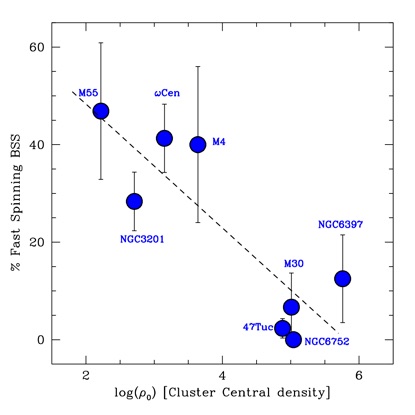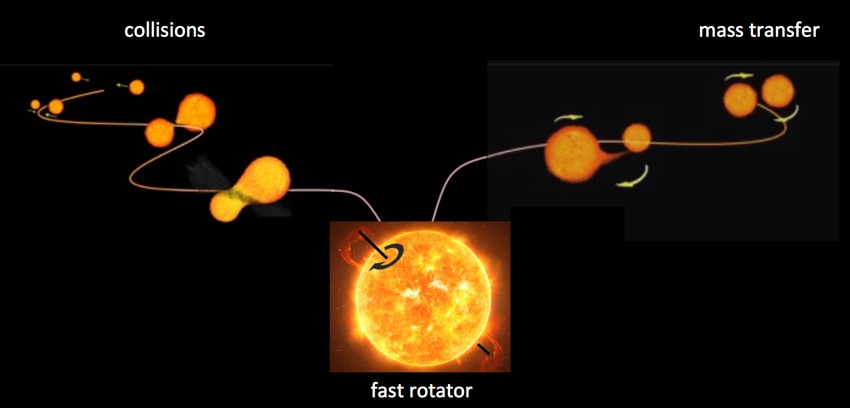Blue straggler stars (BSSs) are mysterious and, at the same time, fascinating cosmic objects: they are expected to be the result of direct stellar collisions, or vampirism phenomena between two companion stars in a binary system. Thus, BSSs can be considered as a sort of reborn (revenant) stars, and their very existence is the manifestation that exotic phenomena like stellar collisions and vampirism are occurring in old stellar clusters. A group of scientists led by Prof. Ferraro at the Department of Physics and Astronomy of the Bologna University has discovered that young (newly-formed) BSSs prefer low density environments with respect to high-density star clusters. The discovery has been published in the 15th May 2023 issue of Nature Communications.
Young blue straggler prefer quite environments
The discovery in a nutshell
Both the BSS formation mechanisms predict that a newly formed BSS initially rotates very fast (as a sort of cosmic spinning top), and then progressively slows down. Thus, the measurement of rotation velocity can be used as a powerful diagnostic to distinguish newly formed BSSs (just reborn stars), from older (slowly rotating) BSSs. The published study consists in the first systematic investigation of the BSS rotation velocity in stellar clusters with different structures. The study demonstrates that the fraction of fast rotating BSSs (with rotation velocities larger than 40 km/s) increases for decreasing central density of the host system, thus indicating low-density environments as the natural habitat for stellar reborning. This provides the first sharp relation ever found between the physical properties of BSSs and their host environment.
This study identified BSSs with rotation velocities up to 100 times that of our Sun, thus demonstrating to be jsu at the beginning of their new live. However, the fraction of fast spinning BSSs is not the same in all environments: fast rotators (with velocities larger than 40 km/s), which correspond to the BSSs formed more recently, don’t like crowded conditions. In fact, about 40% of the BSSs observed in low-density clusters are spinning rapidly, while this percentage decreases to just 3-4% in high-density environments. This is the first clear relation ever found between the physical properties of BSSs and the environment where they form.
For additional information
Francesco Ferraro
email: francesco.ferraro3@unibo.it
tel: +390512095774
mobile: +393666357560


The team:
University of Bologna: Francesco R. Ferraro, Alessio Mucciarelli, Barbara Lanzoni, Cristina Pallanca, Mario Cadelano, Alex Billi
INAF-OAS: Emanuele Dalessandro
McMaster University (Canada): Alison Sills
Indiana University (USA): Enrico Vesperini
European Souhern Observatory (Germania): Giacomo Beccari
Universidad Andres Bello (Chile): Lorenzo Monaco
University of Michigan (USA): Mario Mateo
The discovery has been possible thanks to the analysis of 320 high-resolution spectra of blue stragglers collected in eight Milky Way globular clusters. These stellar aggregates are all extremely old (they formed 12 billion years ago), but they have different strucutral characteristics: four of them (namely, M4, omega Centauri, M55, and NGC 3201) have low central densities, while the remaining four (namely, 47 Tucanae, NGC6397, NGC6752, and M30) are very compact, high-density clusters. Hence, they provide a wonderful natural laboratory to test the behaviour of BSSs.
Illustration of the two formation processes of blue straggler stars (stellar collisions, on the left, mass transfer in binary systems, on the right), which produce a rejuvenated star rapidly spinning around its rotation axis.
Images of the 4 low-density globular clusters analyzed in this study. From left to right: M55, M4, omega Centauri, and NGC 3201.


Images of the 4 high-density globular clusters analyzed in this study. From left to right: 47 Tucanae, M30, NGC 6397, and NGC 6752.

The team answers a few questions about the discovery
1) What implications does your result have? Why does this discovery matter?
This discovery promises to open an unexplored route in the comprehension of the evolutionary processes that guide these stars, likely opening a new window in our understanding of the BSS formation mechanisms in different environments. In fact, it indicates that BSS formation (stellar reborning) is fully ongoing in loose clusters, while it appears to be significantly reduced in high-density environments. Note that BSS formation is the only star formation activity currently ongoing in old star clusters, where the lack of gas prevents the formation of “normal” stars.
The discovery can have deep implications for our understanding of the evolution of star clusters, the role played by binary systems, and the rate of stellar collisions. For instance, it may suggest that primordial binaries have a large survival rate in low density environments, while in conditions of high stellar crowding, recurrent interactions tend to break down binaries.
Our study also provides the first constraints on the timescale of the slow-down processes for collisional BSSs, suggesting that one or two billion years are typically needed to switch off the large initial spinning velocity of these stars.
Relatio bentween the fraction of fast spinning BSSs and the central density of the 8 investigated globular clusters.



2) How did telescopes, instruments and facilities uniquely enable you to achieve this result?
Achieving this result has been possible only thanks to a 15-year long observational campaign with the ESO-VLT. In fact, the accurate measure of rotation velocities requires spectroscopic observations with high spectral resolution, and the FLAMES & UVES spectrographs at the ESO-VLT were the ideal instruments to carry out this study: we acquired more than 300 spectra in 8 different star clusters (7 observed with the ESO-VLT), thus finally collecting the necessary data set to reach these exciting conclusions.
3) What led to this research? What were you hoping to discover? What personally motivated you to do this research and why are you excited about it?
Our group led many observational programmes aimed at understanding the properties and the evolution of BSSs in star clusters. These are indeed exceptionally informative “particles”. Our studies demonstrated that they can provide key information about all the dynamical processes that characterize the time evolution of star clusters.
However, very little is already known about their formation and evolutionary processes, and their theoretical models remain still largely unconstrained by observations. The rotation velocities were among the not yet explored physical properties of BSSs. Now, with this discovery we are able to also trace the recent (possibly 1-2 Gyr old) BSS formation activity due to binary evolution and collisions and explore the conditions that favour the formation of these objects in different environments.
This discovery will trigger new theoretical models of braking mechanisms able to efficiently reduce the initial spinning of BSSs. By combining these observations with suitable models of braking mechanisms we will be soon able to perform a gyro-chronology of BSS formation in clusters, i.e., the determination of the formation epoch of each BSS from the measure of its rotation velocity. This will have a huge impact not only on the reconstruction of BSS evolution, but also on the possibility to estimate the rate of stellar reborning via direct stellar collisions and via mass transfer activity in binary systems, and to determine the role played by dynamical evolution in producing new BSSs.
4) What aspect of your research do you personally think would capture the public imagination? What would grab the attention of someone with no astronomical or scientific background?
The connection between fast rotation and very young stellar age is surely one aspect that can capture the public imagination: “spinning like crazy as a young star”.
Indeed, the measure of rotation is a powerful indicator of youth of all the stars: even normal stars at their birth are expected to be fast rotators and then reduce their rotation velocity because of some braking mechanism. For instance, after 4.5 billion years from its birth, our Sun by now is a very slow rotator (2 km/s).
In our study, some BSSs have been found to rotate even 100 times faster than our Sun! This means that we catched them at the very beginning of their new-life. Our discovery indicates that we now have a new open-access laboratory where we can study the nature and the timescales of the breaking processes that transform a spinning new formed star, in a slow rotator (like our Sun).
5) Will future instrument/telescope allow you to further your research? If so, how?
Surely ELT will allow us to extend this investigation in other environments, as the dwarf galaxies and their clusters in the Local Group, thus providing new information about the role that the environment plays in producing BSSs.
6) Is there anything else you'd like to share with us, e.g., a personal anecdote or story related to this research?
We started this investigation with the conviction that we would have found a lot of fast rotators in high density clusters where collisions are more frequent, perhaps over-estimating the collision rate. The progressive acquisition of this dataset convinced us that the reality is just the opposite: fast rotators prefer low-density environments, indicating that collisions are providing only a few of them, while the vast majority of the fast-spinning BSSs comes from the evolution of binaries. Once more, Nature surprised us.


